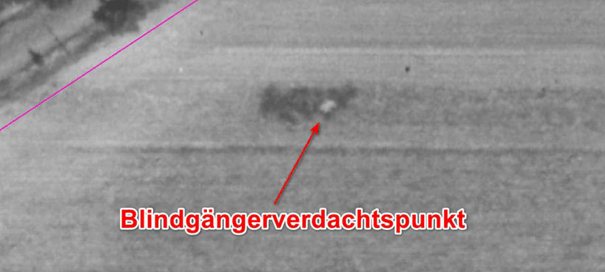Even more than 70 years after the end of the war, there are still numerous explosive ordnance sites underground in the Federal Republic of Germany. In the event of ground interventions, these pose a considerable risk to the protected interests of public safety (in particular life and health, freedom, property of individuals) or public order. Just how topical the problem is was recently demonstrated again in the aftermath of a project for the preliminary investigation of explosive ordnance in the Nienburg area, which was carried out at the Hanover site.
As part of the evaluation of historical aerial photographs from the time of the Second World War, numerous bomb craters were recorded within and in the immediate vicinity of the project area. The corresponding images were taken at the time by the Allied air forces for reconnaissance purposes. They were primarily used to identify potential targets and to monitor the success of bombings.
During the digital stereoscopic aerial photo evaluation, our experienced experts identified not only the clearly visible explosive bomb craters but also a single dud suspect.
In addition to the aerial photographs taken during the war, numerous written sources (including primary sources from the Allied armed forces with cargo lists, etc.) were evaluated during the course of the project. On this basis, a chronicle of the air raids was compiled for the respective location. From the comparison of the available aerial photographs with the attack data, it was possible to deduce that the war impacts visible in the aerial photograph can be traced back to an attack on 05.08.1944 on the nearby Schäferhof tank farm. During this attack, 175 aircraft of the 8th USAAF dropped a total bomb load of approx. 600 tonnes.
As a result of the assessment, it was recommended to investigate the respective suspected areas by means of geophysical soundings prior to ground interventions. In the course of this probing work, a 500 kg unexploded bomb was detected at a depth of about 2 metres on 21 December 2022 and subsequently recovered. The bomb was fitted with a conventional impact fuse, which was removed by specialists from the Lower Saxony Explosive Ordnance Disposal Service.
Even more than 70 years after the end of the war, numerous explosive ordnance are still underground in the Federal Republic of Germany.
Just how topical the problem is was recently demonstrated again in the aftermath of a project for the preliminary investigation of explosive ordnance in the Nienburg area that was carried out at the Hanover site:
In the course of a preliminary exploration for explosive ordnance (Phase A), numerous bomb craters and a single dud were identified. The evaluation of extensive written sources has shown that the war impacts visible in the aerial photograph can be traced back to a raid on 05.08.1944 on the nearby Schäferhof tank farm. During this attack, 175 aircraft of the 8th USAAF dropped a total bomb load of approx. 600 t.
As a result of the assessment, it was recommended that the relevant suspected areas be investigated by means of geophysical soundings prior to ground interventions.
During the subsequent exploratory work, a 500 kg unexploded bomb was detected at a depth of about 2 metres on 21 December 2022 and subsequently recovered. The bomb was fitted with a conventional impact fuse, which was removed by specialists from the Lower Saxony Explosive Ordnance Disposal Service.


